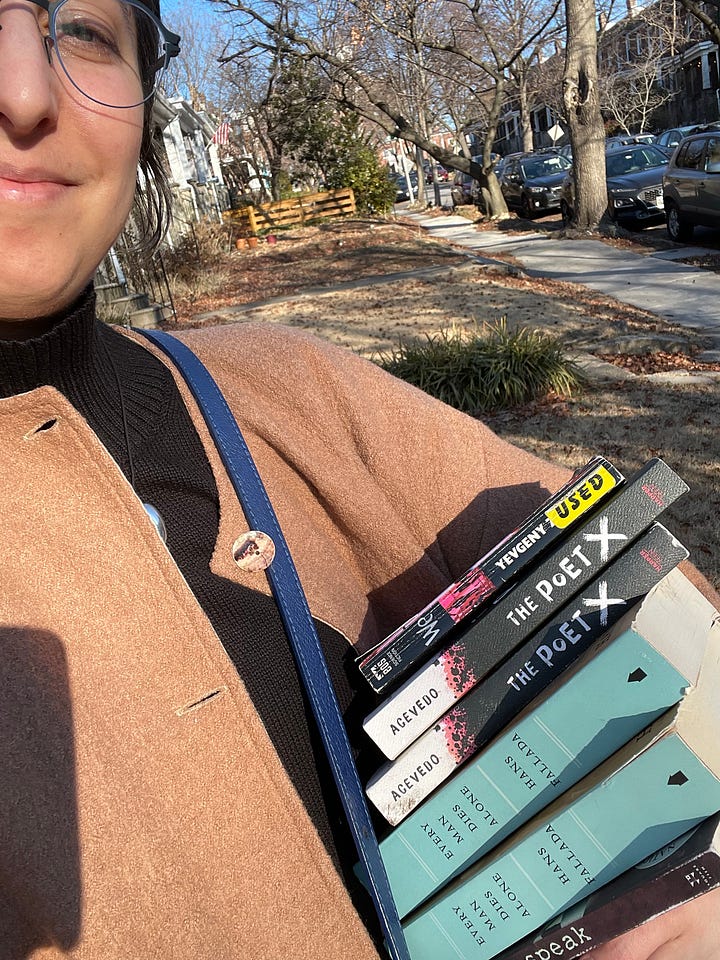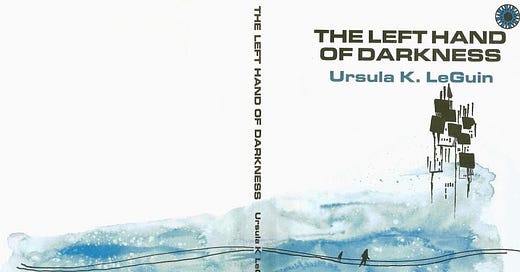Hello friends! This is Ursula Fan Club, where I share what I’m writing, reading, and seeing in the world as I write the first draft of my book. If you’re interested in speculative fiction, the climate, ancestral stuff, textiles, living in a human body, and balancing a creative practice with whatever this is *waves wildly around*, you’ll probably like it here.
This is a post I’ve been meaning to write since I finished my latest re-read of The Left Hand of Darkness by Ursula K. Le Guin.
The first time I read her sci-fi classic, I listened to it on audiobook and have a distinct memory of winding through backroads of the Catskills, in verdant June, while George Guidall’s syrupy voice narrates Genly Ai and Estraven’s journey over the ice. The world-building, naming conventions, and visual descriptions of people and place were lush but sparse enough to invite the reader to imagine their own scene for themselves. In my first read, it was enough for me to just try to follow along with the plot.
My second reading was in print, and that’s when the characters, plot lines, and themes began to settle in for me. But Le Guin, like her Gethenians, is subtle. There was a lot of subtext that I missed, especially regarding characters and their motivations.
My third and most recent reading was the most impactful yet and reinforces my deep love and respect for this book. Le Guin’s description of the politicians of Karhide and Orgoreyn felt especially potent during this moment, with passages like this one:
Tibe spoke on the radio a good deal. Estraven when in power had never done so, and it was not in the Karhidish vein: their government was not a public performance, normally; it was covert and indirect. Tibe, however, orated. Hearing his voice on the air I saw again the long-toothed smile and the face masked with a net of fine wrinkles. His speeches were long and loud: praises of Karhide, disparagements of Orgoreyn, vilifications of “disloyal factions,” discussions of the “integrity of the Kingdom’s borders,” lectures in history and ethics and economics, all in a ranting, canting, emotional tone that went shrill with vituperation or adulation. He talked much about pride of country and love of the parentland […] He wanted his hearers to be frightened and angry. His themes were not pride and love at all, though he used the words perpetually; as he used them they meant self-praise and hate. He talked a great deal about Truth also, for he was, he said, “cutting down beneath the veneer of civilization.”
The Left Hand of Darkness was originally published in 1969. Remind you of anyone?
One of the other things that stuck out to me on this read was the structure of the writing itself. In every chapter, Le Guin alternates voices between Genly Ai, Estraven, and a third-person narration of a Gethen myth, with one outlier chapter through the voice of a Hainish investigator from a past timeline.
Le Guin tells us she will do this from the very first two paragraphs, which go like this:
I’ll make my report as if I told a story, for I was taught as a child on my homeworld that Truth is a matter of the imagination. The soundest fact may fail or prevail in the style of its telling: like that singular organic jewel of our seas, which grows brighter as one woman wears it and, worn by another, dulls and goes to dust. Facts are no more solid, coherent, round, and real than pearls are. But both are sensitive.
The story is not all mine, nor told by me alone. Indeed I am not sure whose story it is; you can judge better. But it is all one, and if at moments the facts seem to alter with an altered voice, why then you can choose the fact you like best; yet none of them are false, and it is all one story.
On my third re-read, I found this opening puzzling, until I began to pay attention to the shifting voice from chapter to chapter. In retrospect, it is now clearly foundational to this book; it could not be the same if it were all told through the voice of Genly Ai or even told in an omniscient third person. At the heart of the story is the animosity, distrust, and then eventual understanding, trust and love between Ai and Estraven; this development can only happen through a reader’s understanding of their experiences and perspectives, told through their own voices.
Here’s how the chapters break down. You’ll see that no two adjacent chapters are in the same voice (edit: with the exception of the final three chapters), and that some of the chapter titles and stories form a pair, a very considered choice given the book’s exploration of binary themes (light/dark, man/woman, Karhide/Orgoreyn, yin/yang, etc.).
Warning: Spoilers ahead! If you have not read this book yet and plan to, proceed with caution.
Chapter 1: A Parade in Erhenrang
Location: Erhenrang, Karhide
Voice: Genly Ai (GA), transcript from his ansible
Chapter 2: The Place Inside the Blizzard
Location: north Karhide
Voice: Myth, archive recorded by GA
Chapter 3: The Mad King
Location: Erhenrang, Karhide
Voice: GA
Chapter 4: The Nineteenth Day
Location: east Karhide
Voice: Myth, archive recorded by GA
Chapter 5: The Domestication of Hunch
Location: Erhenrang —> east Karhide
Voice: GA
Chapter 6: One Way into Orgoreyn
Location: Erhenrang, Karhide —> Orgoreyn
Voice: Estraven—the first chapter in his voice
Chapter 7: The Question of Sex
Location: Not given
Voice: Hainish investigator, an anthropological study
Why is this chapter included here, after the first chapter in Estraven’s voice?
Chapter 8: Another Way into Orgoreyn
Location: Erhenrang, Karhide —> Orgoreyn
Voice: GA
Both entrances to Orgoreyn (chapters 6 and 8) are met with violence. My observation: contested borders, liminal spaces, in-between places where a binary breaks down are sites of suffering and death. This will happen again in the final chapter when Estraven tries to re-enter Orgoreyn at the border with Karhide.
Chapter 9: Estraven the Traitor
Location: Karhide
Voice: Myth, archive recorded by GA
Chapter 10: Conversations in Mishnory
Location: Mishnory, Orgoreyn
Voice: GA
Chapter 11: Soliloquies in Mishnory
Location: Mishnory, Orgoreyn
Voice: Estraven
This chapter forms an obvious pairing with chapter 10 and are presented back to back as these to characters get closer, geographically and otherwise.
Chapter 12: On Time and Darkness
Location: Not given
Voice: Myth, no voice provided
Chapter 13: Down on the Farm
Location: Mishnory, Orgoreyn —> farm/prison of Orgoreyn
Voice: GA
Chapter 14: The Escape
Location: Mishnory, Orgoreyn —> farm/prison of Orgoreyn
Voice: Estraven
Another pairing, back to back with chapter 13.
Chapter 15: To the Ice
Location: Orgoreyn —> over glacier
Voice: GA
Chapter 16: Between Drumner and Dremegole
Location: glacier
Voice: Estraven
This is the last chapter in Estraven’s voice. By this point of the book, there is only one myth chapter left to share (to come in the following chapter), and GA and Estraven are now together and aligned on their purpose and relationship.
Chapter 17: An Orgota Creation Myth
Location: Not given
Voice: Myth
This is the first and only myth told from the POV of Gethens from Orgoreyn, not Karhide, providing a balance and shared ownership of the planet’s story.
Chapter 18: On the Ice
Location: glacier
Voice: GA
Chapter 19: Homecoming
Location: Karhide
Voice: GA
Chapter 20: A Fool’s Errand
Location: Karhide
Voice: GA
Isn’t this incredible? I was floored as I captured this patterning in my latest read and it helped me appreciate Le Guin’s mastery of her storytelling from a structural perspective, not just a world-building and thematic one.
As I read The Left Hand this time and made note of all these considered shifts in voice, it helped me think about my own characters and how I might want to shift between their voices and timelines, too. I haven’t decided which POV to write in—first, third, or even in second person in some instances—and my draft is all over the place. I’m continuing to be fluid in this decision and write in whichever voice feels most comfortable for the scene I’m working on, with the expectation that I’ll go back and align these in a re-write.
What I’m writing
I finished 5213 words for February on Friday morning, coming in slightly over my 5000 word goal for PARAKEET. Woohoo! Taking a break from my manuscript this weekend before our next round of monthly PARAKEET meetings kicks off Monday night with a new monthly goal.
What I’m reading
Yikes, I’m behind on finishing Make Your Art No Matter What: Moving Beyond Creative Hurdles by Beth Pickens for book club. I’m planning to finish this week so my next post can be about this book.
Also reading The Plot Against America by Philip Roth, Recovering: A Journal by May Sarton, Woman on the Edge of Time by Marge Piercy, and What If We Get It Right? Visions of Climate Futures, edited by Ayana Elizabeth Johnson for book club.
What I read
I started and finished The Moon is Down by John Steinbeck in four days, on a recommendation from a good friend. Steinbeck’s parable became the most popular written propaganda during Nazi occupation and was secretly translated into French, Norwegian, Danish, Dutch, Swedish, German, Italian and Russian with hundreds of thousands of copies illegally printed and distributed. While American critics derided it, its impact only came to light after the end of the war when Steinbeck and the West realized that it had been a source of fuel for those resisting the Third Reich. Chills.
A helpful thing
Books that fight fascism have been coming in and I’ve been distributing them in my area. Join me!








